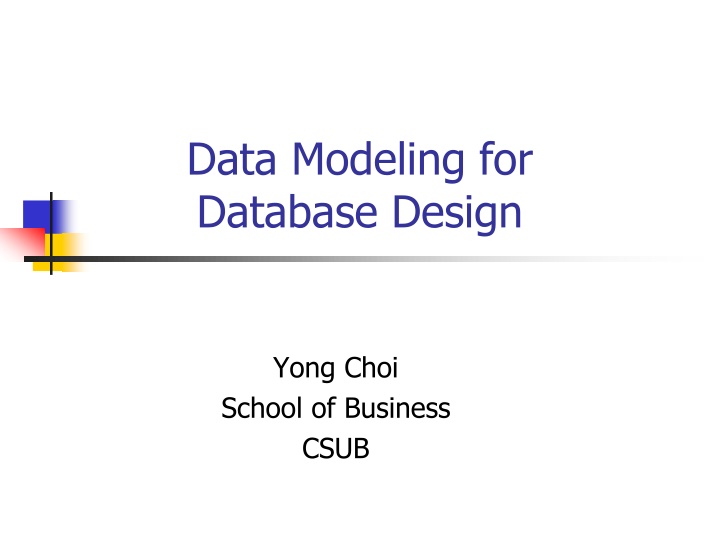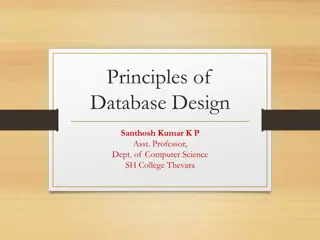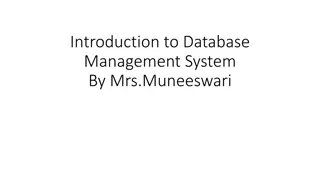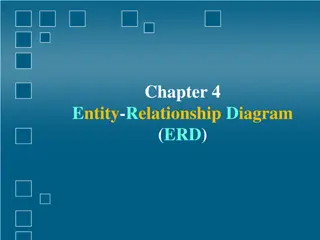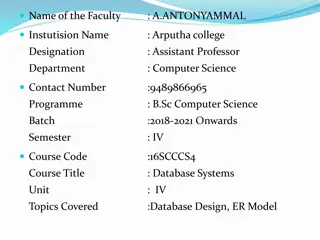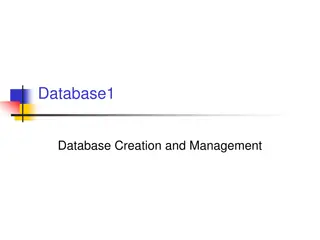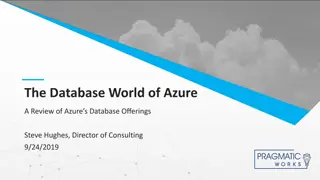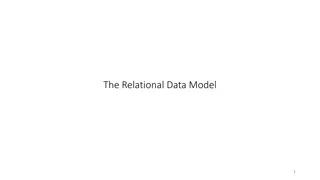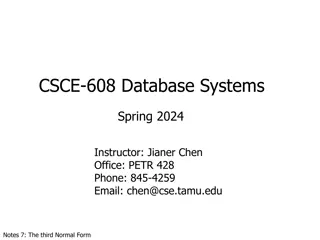Data Modeling for Database Design Essentials
In this tutorial, delve into the fundamentals of data modeling for effective database design. Learn about entity relationships, ERD components, modeling symbols, and business rules. Discover the significance of data modeling in organizational analysis and user data requirements. Explore the importance of data models as a communication tool among stakeholders.
Download Presentation

Please find below an Image/Link to download the presentation.
The content on the website is provided AS IS for your information and personal use only. It may not be sold, licensed, or shared on other websites without obtaining consent from the author.If you encounter any issues during the download, it is possible that the publisher has removed the file from their server.
You are allowed to download the files provided on this website for personal or commercial use, subject to the condition that they are used lawfully. All files are the property of their respective owners.
The content on the website is provided AS IS for your information and personal use only. It may not be sold, licensed, or shared on other websites without obtaining consent from the author.
E N D
Presentation Transcript
Data Modeling for Database Design Yong Choi School of Business CSUB
Part # 2 Study Objectives Understand concepts of data modeling and its purpose Learn how relationships between entities are defined and refined, and how such relationships are incorporated into the database design process Learn how ERD components affect database design and implementation Learn how to interpret the modeling symbols Learn how to define the business rules 2
Part # 2 Data Model Read chapter 2 at least few times Model: an abstraction of a real-world object or event Useful in understanding complexities of the real- world environment Data model A diagram (ERD) that displays a set of tables and the relationships between them Next Slide: Restaurant Access data model
Part # 2 Data Model by Access: Entity Relationship Diagram (ERD) 4
Part # 2 Entity Relationship Diagram (ERD) ERD is a data modeling methodology used in software engineering to produce a conceptual data model of a database system. Our choice of methodology Data Modeling Video (stop @ 9:20) Basic overview of data modeling using ERD No need to understand everything! Introduction of essential ERD terms: entity, cardinality, business rules, etc 5
Part # 2 Data Modeling The data modeling revolves around discovering and analyzing organizational and users (e.g., employees) data requirements. The requirements for the model development must be based on policies, stakeholders (e.g., survey, discussion, observation, etc.), business procedures, system specifications, and so on. Identify what data is important! Identify what data should be maintained! 6
Part # 2 Importance of Data Model Blue print Official documentation: Blue Print of Architecture Data Model vs. list of Excel tables Understandable w/o DB knowledge Effective Communication Tool Improve interaction among various stakeholders (senior managers, DB developers, and ordinary employees .) DB Model = Actual DB Example on the website
Part # 2 Data modeling by ERD To construct a model, the first three major activities are identifying Entity, Attribute, and Relationship Entity table Attribute column (data item) Relationship line 8
Part # 2 How to find entities? Entity: "...anything (people, places, objects, events, etc.) about which we need to store information (e.g., supplier, machine tool, employee, utility pole, airline seat, etc.). Tangible: customer, product Intangible: order, account payable Look for singular nouns (beginner) BUT a proper noun is not a good candidate . 9
Part # 2 Entity Instance A single occurrence of an entity (# of records). Student ID 2144 3122 3843 9844 2837 2293 Last Name Arnold Taylor Simmons Macy Leath Wrench First Name Betty John Lisa Bill Heather Tim Entity: student Six instances 10
Part # 2 How to find attribute? Attribute: Attributes are data objects that either identify or describe entities(property of an entity). In other words, it is a descriptor whose values are associated with individual entities of a specific entity type The process for identifying attributes: look for names that appear to be descriptive noun phrases. 11
Part # 2 How to find relationships? Relationship: Relationships identify and describe associations between entities. Typically, a relationship is indicated by a verb connecting two or more entities. Employees are assigned to projects Relationships should be classified in terms of cardinality. One-to-one, one-to-many, etc. 12
Part # 2 How to find cardinalities? Cardinality: The cardinality is the number of occurrences in one entity which are associated to the number of occurrences in another entity. Cardinalities of Access ERD (next slide) There are three basic cardinalities: one-to- one (1:1), one-to-many (1:M), and many-to- many (M:N) 13
Part # 2 Data Model by Access: Entity Relationship Diagram (ERD) 14
Part # 2 Identifier attributes that uniquely identify entity instances Becomes a PK in RDS Composite identifiers (composite PK) are identifiers that consist of two or more attributes Identifiers are usually represented by underlying the name of the attribute(s) Employee (Employee_ID), student (Student_ID) 15
Part # 2 Crow s Foot Notation Known as IE (information engineering) notation more intuitive than other notations Entity: Represented by a rectangle, with its name on the top. The name is singular (entity) rather than plural (entities). Example: student, Customer, etc. 16
Part # 2 Attribute Identifier(s) must be represented by underlying the name of the attribute(s) 17
Part # 2 Three Basic Cardinalities 1-to-1 relationship 1-to-M relationship M-to-N relationship
Part # 2 Cardinality con t Missing mandatory cardinality will not be penalized for the data modeling test. Identical concept of Or operator. If either of cardinality is satisfied, then ok
Part # 2 Mandatory Relationship At least one record (instance) of one table (entity) must participate in a relationship with another table. Table A (Customer), Table B (Order) 20
Part # 2 Mandatory Relationship con t No order can exist in a database unless it has first been placed by a customer. Therefore, at least one record must exist in the Customer table before any records can be added to the Order table. Source: https://www.relationaldbdesign.com/relational-database-design/module6/mandatory-optionalRelationship-participation.php 21
Part # 2 Very Simple Data Model Example 22
Part # 2 ERD Development Procedure 1 Understand Business Rules (BR) BR determine (or dictate) how the organization data should be managed and controlled. Example of Business Rules A student may register for a section of a course only if a student has successfully completed the prerequisites for the course. A preferred member hotel customer can reserve more than one hotel room at once but a regular customer is allowed to reserve one room at a time. 23
Part # 2 ERD Development Procedure 2 Sources of Business Rules (every where ) Organizational documents: business transactions, personal manuals, policies, contracts, annual report, Mktg brochures, technical instructions, etc. Various business-related input by stakeholders (e.g., survey, interview note, meeting minutes, etc) Site visitations and observations of work process or procedure
Part # 2 Benefits of BR Allow us to understand business processes, the nature, role and scope of the data. Allow us to develop relationship participation rules (cardinality) and constraints to create a correct data model. Help standardize the company s view of the data. A communication tool among stakeholders 25
Part # 2 ERD Development Procedure 3 Useful BR vs Useless BR A valued customer qualifies for purchasing more than three products at once unless a customer has an over due account balance. Friday is business casual dress day. Iterative process .. Move together until optimized .not finalized. BR 1st, 2nd ,3rd ,4th . ERD 1st, 2nd ,3rd ,4th Will not be concerned with Mandatory cardinality (no penalty!) 26
Part # 2 Example of ERD and BR 1 Every student must be treated equally according our US Federal Government. That is, each full or part time student must be allowed to be enrolled in curriculums equally. Therefore, each curriculum should be available to all of our registered students. Two entities (Student, Curriculum), Relationship, and cardinality
Part # 2 Example of ERD and BR 2 Official (optimized) Business Rule: bi-directional A student has to be enrolled in many curriculums (cardinality: student to Curriculum). Each curriculum might be studied by many students (cardinality: Curriculum to student). Whenever possible, Active & Passive for differentiation of bi-directional BR
Part # 2 Example 1 No Attributes! A department (must, may) hires many employees. An employee (must be, can be) is hired by one department.
Part # 2 Example 2 No Attributes! A manager manages one department. A department must be managed by at least one manager.
Part # 2 Example 3 No Attributes! An author (must, may) writes many books. A book is (might be) written by many authors.
Part # 2 Practice 1 No Attributes! A customer (can) orders multiple products. Each product must be ordered by one customer
Part # 2 Practice 2 No Attributes! A faculty may teach multiple courses. A course must be taught by exactly one faculty.
Part # 2 Example 4 (No Attributes) Finalized (or optimized) business rules must be bi-directional. Draft: one sentence Finalized: two sentences A professor must advise many students (professor to student). Each student has to be advised by one professor (student to professor). A professor must teach many classes. Each class must be taught by one professor. 34
Part # 2 Practice 3 (No Attributes) A sales representative must write many invoices. Each invoice should be written by one sales representative. Each department must have only one sales representative. Each sales representative is assigned to many departments. A customer may have many invoices. Each invoice must be generated for only one customer. 35
Part # 2 Eliminate unnecessary information (No Attributes) Each California State University campus should have a sufficient number of professors for teaching various courses. Each department must have at least one professor on each CSU campus. In some cases, a professor can be assigned to a department at all.
Part # 2 Practice 4 According to the policy of Mercy Hospital, a patient should have a patient record. Specifically, each patient may have one or more records. Each patient record can be assigned to one patient.
Part # 2 Practice 5 The California State University has changed the course schedule policy based upon feedback from professors and students. According to the changed policy, each course may have exactly one or more sections, or may not have a section at all. However, each section must be assigned to one course.
Part # 2 Practice 6 CSUB is the only 4 years comprehensive university in Kern County. Each class offered by CSUB may be taught by several professors. A particular class may always uses the same classroom. Because classes may held at different times or on different evenings, it is possible that each classroom is used by many different classes. By the way, A professor can teach several classes.
Part # 2 ERD Development Simulation Using the original notation by Peter Chen Some still prefer to use the original notation Assume that draft BRs have been generated. Entity Attributes (as well as identifier) Relationship Cardinality 1. 2. 3. 4. 41
Part # 2 Entities??? Original Data Model Notation Used (Peter Chen) ANG Laboratory has several chemists who work on one or more projects. Chemists also may use certain kinds of equipment on each project. The organization would like to store the chemist s employee identification number, his/her name, up to three phone numbers, his/her project identification number and the date on which the project started. Every piece of equipment, the chemist uses, has a serial number and a cost.
Part # 2 Entities Project Chemist Equipment
Part # 2 Entities Attributes??? ANG Laboratory has several chemists who work on one or more projects. Chemists also may use certain kinds of equipment on each project. The organization would like to store the chemist s employee identification number, his/her name, up to three phone numbers, his/her project identification number and the date on which the project started. Every piece of equipment, the chemist uses, has a serial number and a cost.
Part # 2 entities, attributes and identifiers Phone# Start-Date Emp# Proj# Project Chemist Serial# Equipment cost 45
Part # 2 Relationships ??? ANG Laboratory has several chemists who work on one or more projects. Chemists also may use certain kinds of equipment on each project. The organization would like to store the chemist s employee identification number, his/her name, up to three phone numbers, his/her project identification number and the date on which the project started. Every piece of equipment, the chemist uses, has a serial number and a cost.
Part # 2 Entities/Relationships & their Attributes Start-Date Proj# Project Works-On Phone# Emp# Chemist Serial# Equipment Uses cost
Part # 2 Cardinality The organization would like to store the date the chemist was assigned to the project and the date an equipment item was assigned to a particular chemist working on a particular project. A chemist must be assigned at least to one project and one (or more) equipment. Projects and each equipment must be managed by only one chemist. A project need not be assigned an equipment and vice versa. 48
Part # 2 Complete ER Diagram using the Original Notation Start-Date Proj# 1 N Project Works-On Phone# Emp# Chemist Serial# 1 N Equipment Uses cost
Part # 2 ERD Notation Practice Redraw the Previous ERD using Crow s Foot Notation Entity rectangle Attributes Identifier (underlined) Relationship (no change) Cardinality (very different) 50
